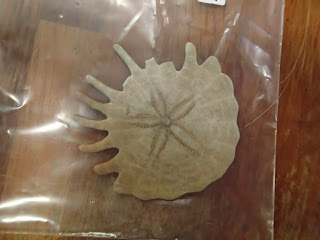I saw this on the shelf next to me when I was putting on my lab coat, and it's a squid so I must have missed it last lab when we covered molluscs. It's a shame because cephalopods are my favourite class so far!
This curious object is called the Aristotle's Lantern. It has absolutely nothing to do with light, it is in fact the "mouth parts" of a sea urchin- if you have the shell of one, it sits at the bottom where the large hole is. It is an extremely complicated structure and has five sharp teeth at the bottom, which are what enable it to be absolutely devastating to kelp forests!
This urchin has adapted to grow some of its spines into plates. These serve to absorb shock from large waves, so this species is found in places where there are frequent storm surges, and other organisms cannot survive.
I have always loved the simplicity of "sand dollars". I have a tiny fossilised one at home- they are a very old species!
This urchin has sulphur-using (I forgot the word, it's been a long day!) bacteria in its stomach that allow it to bury itself and survive deeper in the sediment than other organisms.
Also from the last practical is perhaps one of my favourite marine animals of all time- the nautilus! Its shell is adapted for buoyancy, and the way in which each segment inside the shell is curved (I can't remember if they are concave or convex) means that it is one of the strongest shells in marine biology. It can survive at depths of up to around 700m!
I'm not sure what this is, but it looks like a sand dollar trying to be a starfish. Or a paint splat.
This thing is a basket star, my favourite specimen of the practical. It has many very thin, very tangly arms that are used to snare its prey and bring it towards its stomach, located in the flat central part in the left of the photo. The star then literally vomits its stomach out to digest the prey externally.
Not a single person- including myself- attempted to draw any of the basket stars, for good reason. Although I feel like I have been challenged, so I might give it a go later.
This is a crinoid (also known as a feather star), and I think they look rather beautiful. They resemble a stone flower when preserved like the one in the photo, but live ones look more colourful. They are in a different class to starfish, but the same phylum (Echinodermata).
This (I think) is a large cushion star. Cushion stars have an enlarged central disc, with arms shortened so they are merely corners of a pentagon. I've always thought they look quite comfortable, but they are very knobbly and hard.
This is a close-up of the cushion star, revealing the rough, patterned surface.
This is what the Aristotle's Lantern looks like inside the sea urchin. It really is a peculiar structure, and it does somewhat resemble a lantern.
The underside of the sea star in the picture above.
Bits of brittle sea stars. They usually have very long arms which tend to snap off when in their dry form, which is why they have their nickname. In some very acidic oceans (caused by increased carbonic acid formed when CO2 is dissolved in seawater) if the sea stars try to move, their arms will snap off while they are still alive!
I found the curled arms of the basket star so beautifully complicated I couldn't really stop taking photos. I took 72 in the whole practical!
In the weeks between now and when the Christmas holidays start I will have some boat work, which I am looking forward to. The lecturer briefly told us we would get to see some of the organisms we saw in these practicals alive, so the camera will definitely be joining me! I will find out when this is happening, and may write another blog post before then if it is in a while.
That's enough from me for today, I'm off to the Hobbit for a Frodo.


























No comments:
Post a Comment